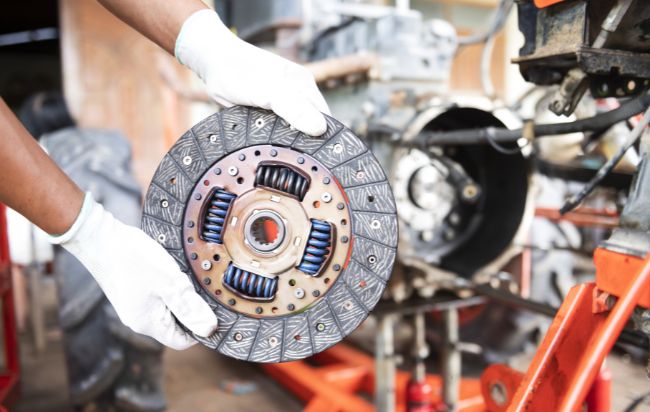
What Is the Clutch?
The clutch consists of three main parts. Always in motion, the flywheel is connected to the motor and works with the clutch disc, also known as the clutch plate. The pressure plate applies force to the clutch plate, helping it engage better with the flywheel. Collectively, these aspects create a link between the engine and the transmission system, powering the two shafts that help your vehicle move.
Many people think the clutch helps the car stay in neutral gear but it separates the transmission from the drivetrain. When the clutch is engaged, it’s able to connect and align with the engine, which then transfers its motion to the transmission system, where it travels from the drive shaft to the wheels.
When the driver presses the clutch pedal to disengage this motion, the clutch disc loosens up against the flywheel to stop spinning and temporarily disconnects the wheels from the engine’s motion. At this point, you can switch gears. As a result, parts undergo a significant degree of friction and will start to wear down over time. At some point, your clutch will need to be repaired.
However, certain habits can cause it to wear out prematurely. For instance, using the clutch constantly instead of employing the handbrake, including when you’re stopped. Drivers who regularly use their vehicle on hilly terrain tend to see the clutch give out sooner than those in flatter areas. If friction wears the clutch down too much, you may find it difficult to drive your car – if it moves at all.
Common Clutch Issues
It’s time to get your clutch examined if you notice one of more of the following issues:
- Slipping: A clear indicator of decreased performance, your car seems sluggish as you accelerate forward, uphill in a high gear or when towing a trailer. Your vehicle may stall rather than go faster.
- Noise: You’ll hear a grinding, squealing or chattering sound, accompanied by a jerking or vibrating movement. This can indicate one or more parts has worn down too far, warped or become loose.
- Burning: If the clutch becomes overheated, you may notice a burning smell as you drive.
Clutch Repairs
Considering the scope and expense of rebuilding a transmission system, repairing or replacing the clutch is a relatively straightforward task. Depending on the issue:
- A part of the clutch may need to be replaced. More commonly, the clutch disc or pressure plate wears out to the point it’s not performing up to par and a new one will need to be installed.
- Aspects related to the clutch are behind its sluggishness. Particularly, the hydraulic line involved will sprout a leak or contain air bubbles.
- Replacing the full clutch, including the pressure plate and all bearings. This service may be recommended if more than one part is worn.
Costs related to clutch repair are not uniform. If you drive a sports or high-performance car, prices for replacement parts tend to be higher.
Is your clutch making noise or frequently slipping? Bring your car to DaSilva’s Auto Body for diagnostic testing and repairs. To schedule an appointment, contact our Naugatuck shop today.

